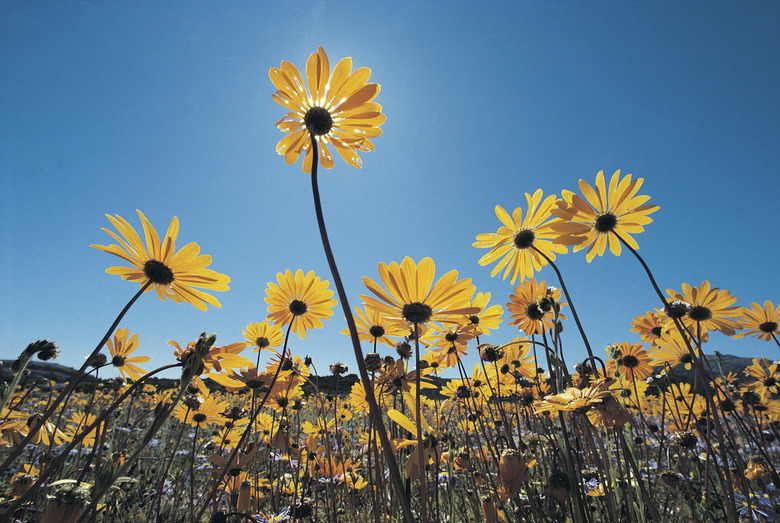Explain Photosynthesis
Plants usually receive credit for being the base of food chains. Less well-known but equally important are algae, which also perform the important task of changing carbon dioxide to oxygen. Plant-like protists, one-celled organisms containing chloroplasts, make their own contribution to the food chain and the conversion of carbon dioxide to oxygen. What do these organisms have in common? They all perform photosynthesis.
The Photosynthesis Process
The Photosynthesis Process
The photosynthesis process uses the sun's energy to combine carbon dioxide and water to form glucose, a sugar. Carbon dioxide enters plants through tiny pores in the bottoms of leaves or by diffusion through cell membranes in the case of algae and protists. Water enters by a variety of means, usually roots, but also by osmosis, which lets water pass through the cell membranes. The sun's energy, absorbed by the green chemical chlorophyll, fuels the chemical reaction that combines the carbon dioxide molecules with the water molecules to form glucose, one type of sugar, and release oxygen as a waste product. The glucose can be stored in fruits, roots and stems of plants and released through the reverse process of respiration, where oxygen is used to break the glucose down into carbon dioxide and water, releasing the stored energy.
The Equation for Photosynthesis
The Equation for Photosynthesis
The photosynthesis equation is written as: 6H2O + 6CO2 → C6H12O6 + 6O2 and is explained in words as the reaction of six water molecules with six carbon dioxide molecules yielding one glucose molecule and six oxygen molecules. Note that one oxygen molecule contains a pair of oxygen atoms.
Photosynthesis Definition
Photosynthesis Definition
The word photosynthesis literally breaks down into "photo," Greek for "light," and "synthesis," a Greek word meaning "composition" or putting together. So, photosynthesis actually means to put together using light. Plants, algae and plant-like protists use sunlight to put together carbon dioxide and water to make sugar.
Importance of Photosynthesis
Importance of Photosynthesis
A chemical explanation of photosynthesis doesn't begin to convey the importance of this process. Earth's early atmosphere, composed of carbon dioxide and other gases spewed out of volcanoes, gradually changed to the modern oxygen-rich atmosphere by photosynthesizing blue-green algae. The conversion of carbon dioxide and water to sugar provides food not only for the plant but also for almost all animal life. While plants provide most of the food on land, algae and plant-like protists provide food for most aquatic food chains. Over time, many interdependent relationships between plants and animals have developed, like the pollination of plants by insects, birds or bats. Ultimately, however, many plants would survive without animals, but most animals cannot live without plants or other photosynthesizing organisms.
Photosynthesis vs. Chemosynthesis
Photosynthesis vs. Chemosynthesis
It is hard to explain photosynthesis without a brief note regarding chemosynthesis. Chemosynthesis uses chemical reactions to release energy and form sugars. While photosynthetic reactions only have one equation, chemosynthetic reactions vary depending on the organism. One chemosynthetic reaction, performed by bacteria at deep-sea hydrothermal vents, combines hydrogen sulfide, oxygen and carbon dioxide to form formaldehyde (H-CHO, sometimes written as CH2O) and release sulfur and water. Other chemosynthetic bacteria oxidize methane or reduce sulfides to release energy. Chemosynthetic bacteria form the base of the food chain in deep ocean communities where sunlight doesn't penetrate. Chemosynthetic bacteria also occur in some hot springs on land.
References
- University of Illinois: The Photosynthetic Process
- Estrella Mountain Community College: Photosynthesis
- Smithsonian Science Education Center: What Is Photosynthesis?
- University of Michigan: Evolution of the Atmosphere: Composition, Structure and Energy
- NOAA Ocean Explorer: What Is the Difference Between Photosynthesis and Chemosynthesis?
- Online Etymology Dictionary: Photosynthesis
Cite This Article
MLA
Blaettler, Karen G. "Explain Photosynthesis" sciencing.com, https://www.sciencing.com/explain-photosynthesis-5476276/. 25 September 2018.
APA
Blaettler, Karen G. (2018, September 25). Explain Photosynthesis. sciencing.com. Retrieved from https://www.sciencing.com/explain-photosynthesis-5476276/
Chicago
Blaettler, Karen G. Explain Photosynthesis last modified August 30, 2022. https://www.sciencing.com/explain-photosynthesis-5476276/
